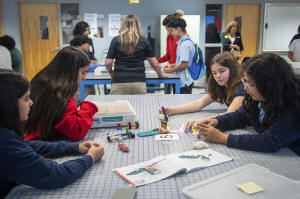Girls fell behind boys in math during the pandemic. Schools are trying
to make up lost ground
[September 05, 2025]
By ANNIE MA and SHARON LURYE
IRVING, Texas (AP) — Crowded around a workshop table, four girls at de
Zavala Middle School puzzled over a Lego machine they had built. As they
flashed a purple card in front of a light sensor, nothing happened.
The teacher at the Dallas-area school had emphasized that in the
building process, there is no such thing as mistakes. Only iterations.
So the girls dug back into the box of blocks and pulled out an orange
card. They held it over the sensor and the machine kicked into motion.
“Oh! Oh, it reacts differently to different colors,” said sixth grader
Sofia Cruz.
In de Zavala’s first year as a choice school focused on science,
technology, engineering and math, the school recruited a sixth grade
class that’s half girls. School leaders are hoping the girls will stick
with STEM fields. In de Zavala’s higher grades — whose students joined
before it was a STEM school — some elective STEM classes have just one
girl enrolled.
Efforts to close the gap between boys and girls in STEM classes are
picking up after losing steam nationwide during the chaos of the
COVID-19 pandemic. Schools have extensive work ahead to make up for the
ground girls lost, in both interest and performance.
In the years leading up to the pandemic, the gender gap nearly closed.
But within a few years, girls lost all the ground they had gained in
math test scores over the previous decade, according to an Associated
Press analysis. While boys' scores also suffered during COVID, they have
recovered faster than girls, widening the gender gap.

As learning went online, special programs to engage girls lapsed — and
schools were slow to restart them. Zoom school also emphasized rote
learning, a technique based on repetition that some experts believe may
favor boys, instead of teaching students to solve problems in different
ways, which may benefit girls.
Old practices and biases likely reemerged during the pandemic, said
Michelle Stie, a vice president at the National Math and Science
Initiative.
“Let’s just call it what it is,” Stie said. “When society is disrupted,
you fall back into bad patterns.”
The pandemic upended progress toward closing the gender gap
In most school districts in the 2008-2009 school year, boys had higher
average math scores on standardized tests than girls, according to AP's
analysis, which looked at scores across 15 years in over 5,000 school
districts. It was based on average test scores for third through eighth
graders in 33 states, compiled by the Educational Opportunity Project at
Stanford University.
A decade later, girls had not only caught up, they were ahead: Slightly
more than half of districts had higher math averages for girls.
Within a few years of the pandemic, the parity disappeared. In
2023-2024, boys on average outscored girls in math in nearly nine out of
10 districts.
A separate study by NWEA, an education research company, found gaps
between boys and girls in science and math on national assessments went
from being practically non-existent in 2019 to favoring boys around
2022.
Studies have indicated girls reported higher levels of anxiety and
depression during the pandemic, plus more caretaking burdens than boys,
but the dip in academic performance did not appear outside STEM. Girls
outperformed boys in reading in nearly every district nationwide before
the pandemic and continued to do so afterward.
“It wasn’t something like COVID happened and girls just fell apart,”
said Megan Kuhfeld, one of the authors of the NWEA study.

Initiatives to boost girls' confidence in STEM lost traction
In the years leading up to the pandemic, teaching practices shifted to
deemphasize speed, competition and rote memorization. Through new
curriculum standards, schools moved toward research-backed methods that
emphasized how to think flexibly to solve problems and how to tackle
numeric problems conceptually.
Educators also promoted participation in STEM subjects and programs that
boosted girls’ confidence, including extracurriculars that emphasized
hands-on learning and connected abstract concepts to real-life
applications.
[to top of second column]
|

Students work on a project during a LEGO Education science lesson at
Lorenzo De Zavala Middle School on Thursday, Aug. 21, 2025, in
Irving, Texas. (AP Photo/Ronaldo Bolaños)

When STEM courses had large male enrollment, Superintendent Kenny
Rodrequez noticed girls losing interest as boys dominated classroom
discussions at his schools in Grandview C-4 District outside Kansas
City. Girls were significantly more engaged after the district moved
some of its introductory hands-on STEM curriculum to the lower grade
levels and balanced classes by gender, he said.
When schools closed for the pandemic, the district had to focus on
making remote learning work. When in-person classes resumed, some of
the teachers had left, and new ones had to be trained in the
curriculum, Rodrequez said.
“Whenever there’s crisis, we go back to what we knew," Rodrequez
said.
Bias against girls in STEM persists
Despite shifts in societal perceptions, a bias against girls
persists in science and math subjects, according to teachers,
administrators and advocates. It becomes a message girls can
internalize about their own abilities, they say, even at a very
young age.
In his third grade classroom in Washington, D.C., teacher Raphael
Bonhomme starts the year with an exercise where students break down
what makes up their identity. Rarely do the girls describe
themselves as good at math. Already, some say they are “not a math
person.”
“I'm like, you're 8 years old," he said. "What are you talking
about, ‘I’m not a math person?'”
Girls also may have been more sensitive to changes in instructional
methods spurred by the pandemic, said Janine Remillard, a math
education professor at the University of Pennsylvania. Research has
found girls tend to prefer learning things that are connected to
real-life examples, while boys generally do better in a competitive
environment.
“What teachers told me during COVID is the first thing to go were
all of these sense-making processes,” she said.

A school district renews its commitment
At de Zavala Middle School in Irving, the STEM program is part of a
push that aims to build curiosity, resilience and problem-solving
across subjects.
Coming out of the pandemic, Irving schools had to make a renewed
investment in training for teachers, said Erin O’Connor, a STEM and
innovation specialist there.
The district last year also piloted a new science curriculum from
Lego Education. The lesson involving the machine at de Zavala, for
example, had students learn about kinetic energy. Fifth graders
learned about genetics by building dinosaurs and their offspring
with Lego blocks, identifying shared traits.
“It is just rebuilding the culture of, we want to build critical
thinkers and problem solvers,” O'Connor said.
Teacher Tenisha Willis recently led second graders at Irving's
Townley Elementary School through building a machine that would push
blocks into a container. She knelt next to three girls who were
struggling.
They tried to add a plank to the wheeled body of the machine, but
the blocks didn't move enough. One girl grew frustrated, but Willis
was patient. She asked what else they could try, whether they could
flip some parts around. The girls ran the machine again. This time,
it worked.
“Sometimes we can’t give up,” Willis said. “Sometimes we already
have a solution. We just have to adjust it a little bit.”
___
Lurye reported from Philadelphia. Todd Feathers contributed
reporting from New York.
All contents © copyright 2025 Associated Press. All rights reserved
 |